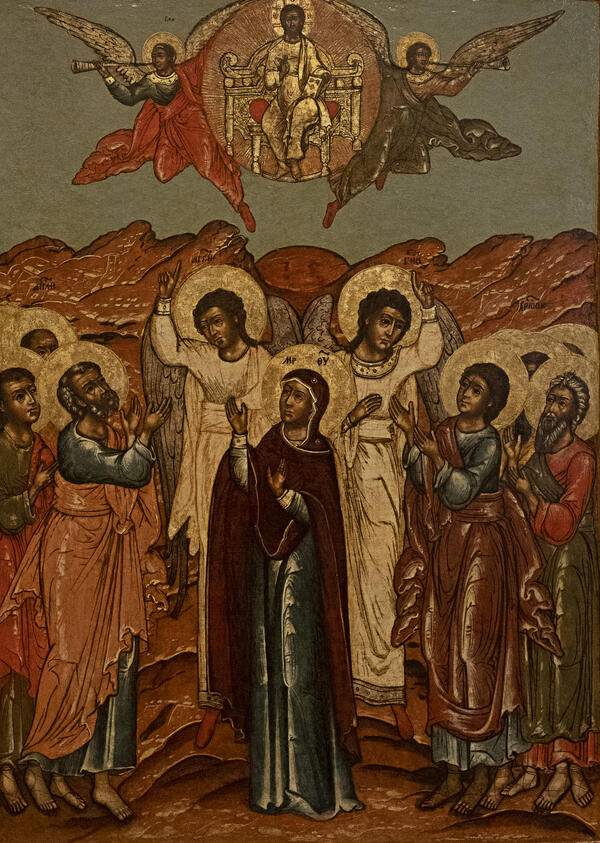The Ascension of Christ is described in the New Testament. According to the sacred texts, after the resurrection, Jesus Christ appeared to his disciples for forty days and talked with them about the matters that they had not been ready to hear earlier or had interpreted in a somewhat false way. After delivering his last speech, Jesus went to the Mount of Olives. There, the Savior raised his hands in a blessing gesture, ascended above the ground and disappeared into a radiant cloud witnessed by the disciples.
The Ascension is one of the main church holidays. It is celebrated on the fortieth day after Easter, on Thursday.
The New Testament text became the source of many icons, which established the iconography of the Ascension.
The initial iconographic image did not literally reproduce the New Testament narrative: the images were more reminiscent of the Easter scenes. Along with the Ascension of Jesus, the icon painters depicted the myrrh-bearing women, who came to His tomb, an angel, and often the hand of God the Father, which reaches down from heaven and raises the Savior. This depiction of the Ascension emphasized the superiority of God the Father in the Holy Trinity.
Gradually, the image of the Ascension grew more similar to the modern version. The icon board was visually divided into two parts. Below was depicted the Mother of God and the Apostle Paul, who was not mentioned in the New Testament texts about the Ascension. Above was the image of the Savior. Experts believe that the earliest remaining images of this kind are the Ascension scenes on the doors of the 5th-century Basilica of Saint Sabina in Rome.
‘The Ascension of Christ’ from the museum’s collection has a traditional composition, which is divided into two meaningful parts. At the top, the Savior ascends to heaven featured as Christ the Almighty. His figure is surrounded by a mandorla (radiance), and two trumpeting angels support it on both sides.
In the center of the lower part of the icon is a mountain, at the top of which there is an imprint of the Savior’s foot. Against the background of the mountain, the Mother of God is represented in the Oranta pose raising her hands in prayer.
The Virgin is flanked by two angels in white robes, who address the apostles and point to the Ascension of Christ. The apostles themselves are split into two symmetrical groups. They are often depicted in motion: one of them looks at the sky while holding his head with his hands, the other point upward.
The icon combines warm red-ocher and olive-blue colors. They emphasize the solemnity of the event and the noble modesty of those present, since the Ascension of Christ is both sorrow and joy.
The Ascension is one of the main church holidays. It is celebrated on the fortieth day after Easter, on Thursday.
The New Testament text became the source of many icons, which established the iconography of the Ascension.
The initial iconographic image did not literally reproduce the New Testament narrative: the images were more reminiscent of the Easter scenes. Along with the Ascension of Jesus, the icon painters depicted the myrrh-bearing women, who came to His tomb, an angel, and often the hand of God the Father, which reaches down from heaven and raises the Savior. This depiction of the Ascension emphasized the superiority of God the Father in the Holy Trinity.
Gradually, the image of the Ascension grew more similar to the modern version. The icon board was visually divided into two parts. Below was depicted the Mother of God and the Apostle Paul, who was not mentioned in the New Testament texts about the Ascension. Above was the image of the Savior. Experts believe that the earliest remaining images of this kind are the Ascension scenes on the doors of the 5th-century Basilica of Saint Sabina in Rome.
‘The Ascension of Christ’ from the museum’s collection has a traditional composition, which is divided into two meaningful parts. At the top, the Savior ascends to heaven featured as Christ the Almighty. His figure is surrounded by a mandorla (radiance), and two trumpeting angels support it on both sides.
In the center of the lower part of the icon is a mountain, at the top of which there is an imprint of the Savior’s foot. Against the background of the mountain, the Mother of God is represented in the Oranta pose raising her hands in prayer.
The Virgin is flanked by two angels in white robes, who address the apostles and point to the Ascension of Christ. The apostles themselves are split into two symmetrical groups. They are often depicted in motion: one of them looks at the sky while holding his head with his hands, the other point upward.
The icon combines warm red-ocher and olive-blue colors. They emphasize the solemnity of the event and the noble modesty of those present, since the Ascension of Christ is both sorrow and joy.


